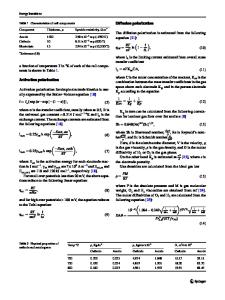Solid Oxide Fuel Cells in Unmanned Undersea Vehicle Applications
- PDF / 689,231 Bytes
- 7 Pages / 612 x 792 pts (letter) Page_size
- 67 Downloads / 385 Views
0973-BB04-07
Solid Oxide Fuel Cells in Unmanned Undersea Vehicle Applications Louis G. Carreiro and A. Alan Burke Energy Systems Branch, Naval Undersea Warfare Center, 1176 Howell Street, Bldg 1302/2 Code 8231, Newport, RI, 02841
ABSTRACT The Navy is currently investigating solid oxide fuel cells (SOFCs) for the propulsion of unmanned undersea vehicles (UUVs). SOFCs are being targeted because of their potential to carry out extended missions, which are not possible using current battery technology. In addition, they offer the advantages of being able to utilize energy-dense hydrocarbon fuels and are self-sustaining while supplying heat to reforming processes. The SOFC system evaluated in this study consisted of a Ni-YSZ-based, 6-cell stack with anode supported cells close-coupled with a micro-channel steam reformer. Various reformate gas compositions, steam to carbon ratios and flow rates were tested to gather a range of data under the expected operating conditions of UUVs. The system was operated for more than 70 hours consuming approximately 0.5 to 0.7 ml/min of fuel and producing about 100 to 230 watts of power. The integrated stack and reformer displayed stable performance with a fuel utilization of 80% and an efficiency of 50% at maximum power output. INTRODUCTION The need for UUVs with extended mission capability has prompted the investigation of power sources that possess high energy density and are capable of operating on logistic fuels (such as diesel and JP-8) in an air-independent environment. SOFCs have been identified as likely candidates for 3-10 kW, UUV propulsion systems since they have the potential for achieving specific energies of greater than 300 Wh/kg. In addition, SOFCs have high electric conversion efficiency, provide useful waste heat and are modular, allowing stacks of different sizes (power ratings) to be readily constructed. The planned UUV energy source will consist of a SOFC fuel cell stack(s), fuel processor (steam reformer) and balance of plant (BoP) components carefully integrated into a UUV platform with emphasis on thermal management of the entire system. A planar stack arrangement was chosen over the tubular design because of its greater volumetric power density. However, the planar configuration requires the use of high temperature seals as well as interconnects with gas flow channels to transport fuel and oxidant to the active areas of the stack. When a planar stack is operated at high temperature (above 700˚C) for long periods of time or during thermal cycling, stability of the seals and oxidation of cell components may become issues, i.e. oxide growth could form on interconnects increasing stack resistance, and sealing materials might fail due to thermal expansion mismatch or oxidative
attack, creating internal and/or external gas leaks in the stack [1]. Despite these potential problems, the planar configuration is still preferred over tubular due to the restricted volume of the UUV energy section. A micro-channel steam reformer was selected that allows for high-fuel proce
Data Loading...











